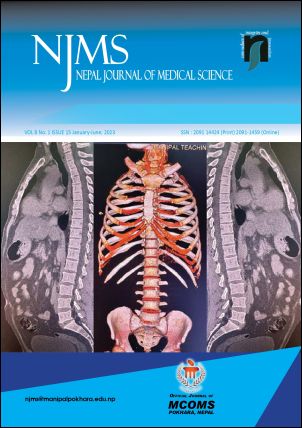Quality of Life of Pregnant Women Attending Antenatal Clinic in a Teaching Hospital, Pokhara
DOI:
https://doi.org/10.3126/njms.v8i1.53662Keywords:
Maternal Health, Pregnant Women, Quality of LifeAbstract
Introduction: Although changes occur in various dimensions in quality of life and it plays a significant role in the health of pregnant women, there are limited data on the quality of life of pregnant women. The objective of the study was to identify the quality of life of pregnant women.
Methods: We conducted a descriptive cross-sectional study in Gandaki Medical College Teaching Hospital and Research Centre, Pokhara in 167 pregnant women attending an antenatal clinic over one month period, selected by nonprobability purposive sampling technique. Data collection was done using the RAND SF-36 questionnaire. Descriptive statistics were used to describe the quality of life. Inferential statistics were used to compare two independent groups and three or more independent groups respectively.
Results: The Mean±SD score for the quality of life of pregnant women was 73.08±14.95 with 62.80±19.14 in the physical component and 83.35±10.76 in the mental component. The score was highest in role limitation due to emotional health and lowest in role limitation due to physical health domain. Women who had planned pregnancies had better scores in the general health domain (p=0.005) and emotional wellbeing domain (p=0.011) compared to those who had an unplanned pregnancies.
Conclusion: Since the quality of life scores are lower in physical health domains than in mental health domains, special attention should be given to the physical health of pregnant women.
Downloads
Downloads
Published
How to Cite
Issue
Section
License
Copyright (c) 2023 Nepal Journal of Medical Sciences

This work is licensed under a Creative Commons Attribution 4.0 International License.
Copyright © by Nepal Journal of Medical Sciences. The ideas and opinions expressed by authors of articles summarized, quoted, or published in full text in this Journal represents only opinions of authors and do not necessarily reflect the official policy of Nepal Journal of Medical Sciences or the institute with which the author(s) is (are) affiliated, unless so specified.




